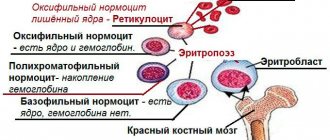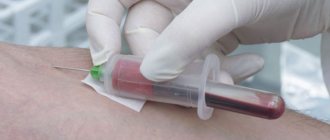The article was checked by gastroenterologist E.G. Melnikova. , is for general informational purposes only and does not replace specialist advice. For recommendations on diagnosis and treatment, consultation with a doctor is necessary.
At the Clinical Hospital on Yauza, diagnostics and treatment of diseases are carried out, in which there is stool with blood, mucus, and black feces. Quick diagnosis includes all the necessary tests - blood, urine, feces, and modern research methods - ultrasound, endoscopic with advanced capabilities (in monochrome light, endosonography), real and virtual colonoscopy (CT version). Conservative and high-tech surgical treatment is carried out (including endoscopic and laparoscopic, abdominal and proctological operations).
Blotches or streaks of blood in the stool appear against the background of the following factors:
Haemorrhoids
The disease is characterized by varicose veins of the anus and rectum. This condition is accompanied by the appearance of hemorrhoids. It develops against the background of stagnation due to a sedentary lifestyle, constipation and excessive body weight. Hemorrhoids also occur during pregnancy.
Characterized by the appearance of dark red blood during bowel movements. It does not mix with feces. Accompanied by itching and burning.
Anal fissure
Accompanied by a rupture of the intestinal mucosa mainly on the wall of the anus. In this case, pain is felt during defecation. The discomfort persists for several hours. Over time, the cracks change - replacement of the mucous tissue with connective tissue is observed.
Colorectal cancer
The malignant process develops due to the degeneration of polyps. Most often it is a hereditary disease. Risk factors include Crohn's disease and ulcerative colitis. The progression of the malignant process occurs slowly. It is characterized by the presence of hidden blood in the stool, weakness, weight loss and anemia.
Ulcerative colitis
Chronic inflammation of the colon mucosa is characterized by the appearance of bloody diarrhea. There are also mucus impurities in the stool. Abdominal pain is not a characteristic symptom. The stool is watery and contains mucus. The complicated course of a chronic disease is accompanied by fever, intoxication of the body, spastic pain and an increase in anemia.
Intestinal inflammation
The inflammatory process occurs against the background of various infectious diseases of a bacterial, viral or parasitic (protozoal) nature: enterovirus, salmonellosis, dysentery, amoebiasis, etc.
Ulcer perforation
If the ulcer perforates, intense bleeding occurs. Accompanied by severe pain in the upper abdomen, dry mouth, excessive sweating and vomiting (black-brown masses).
Intestinal diverticulosis
It is characterized by inflammation of hernial protrusions, which are located on the intestinal walls. The disease does not manifest itself until the inflammatory process develops. Accompanied by hyperthermia and abdominal pain on the left side. Diarrhea or constipation, nausea and vomiting are also common. In case of rupture of diverticula, the development of peritonitis is observed.
Crohn's disease
An inflammatory process affecting the intestinal walls. Accompanied by the appearance of nodules (granulomas). This condition cannot be completely cured - you can only achieve remission. Numerous ulcers appear on the mucous membrane. Bleeding is observed only when the disease is complicated.
How to detect blood in stool
Blood in stool leads to anemia
It often happens that blood in the stool is the only symptom that something incomprehensible is happening in the body. It is very important to pay attention and not miss the following:
- The appearance of blood streaks in the stool that look like “worms”
- Scarlet blood, which can be either on the surface of the stool or remain on toilet paper
- Loose stools with foam and blood
- The stool is liquid, and besides, it contains not only blood, but also mucus. This chair will be somewhat reminiscent of jelly.
- The stool looks like plasticine
- The stool has turned black, and this has nothing to do with eating any food
- In addition, it is worth paying special attention to when blood flows from the anus. Sometimes it's even difficult to stop her. In this case, you should definitely call an ambulance.
Prevention
Preventive measures include timely diagnosis and the appointment of adequate treatment for the pathological process in the body. Also organize proper nutrition to prevent bowel movements.
FAQ
What to do if there is blood in the stool?
If you have bloody stools, consult your doctor to determine the cause. The doctor refers the patient for a comprehensive examination and, based on the results obtained, prescribes treatment.
What examinations need to be completed?
Laboratory diagnosis is required. Recto- and anoscopy are also prescribed to determine pathological changes in the intestinal mucosa.
You can see prices for services
Causes of Visible Blood
In most cases, blood, after it appears in the stool, can be seen with the naked eye. True, not everyone examines their bowel movements, and therefore do not always notice this manifestation. The most common reasons why blood may appear in the stool, and at the same time it will be visible, include:
- Anal fissure. Sometimes patients notice that after bowel movements they feel pain, and during it too. And if you pay attention to the feces, you can see traces of blood on its surface. This indicates that a crack has appeared. The most common cause of anal fissure is recurrent constipation, for which many people go untreated. In this case, blood may be present in the stool for several days until the wound heals. But the next time you touch it, it will start bleeding again
- Haemorrhoids. One of the most common causes of the presence of blood in the stool is hemorrhoids, which also manifests itself with other symptoms, such as itching, pain, burning, and sometimes prolapse of hemorrhoids. Hemorrhoids appear against the background of swelling of the veins, as a result of which, in severe stages, when the veins are damaged by feces, bleeding may begin. Typically the blood will be dark in color.
- Nonspecific ulcerative colitis, during which ulcerations appear on the mucosa and submucosa. In addition to the fact that there will be blood in the patient's stool, traces of pus oozing from the ulcers will also be found. Usually, a person’s well-being sharply deteriorates, he has all the signs of intoxication of the body, diarrhea, abdominal pain
- Crohn's disease, which is considered a hereditary disease, can develop as a result of measles and food allergies. In addition to blood, the stool will be loose, a skin rash, and fever will appear.
- Intestinal infections, which can be of either bacterial or viral origin. If you do not pay attention to this problem in time, blood will appear in the stool due to irritation and inflammation of the mucous membrane.
- Tumors in the intestines, both malignant and benign, which over time begin to put pressure on the blood vessels, causing them to rupture and, as a result, the appearance of blood in the stool
- Dysbacteriosis, especially when it is caused by clostridium
- Sexually transmitted infections
Depending on what caused the appearance of blood in the stool (when a person sees it independently), the treatment prescribed by a specialist will depend. Because it is very important not only to eliminate the symptoms, but also to remove the source of the problem itself.
Crohn's disease
Crohn's disease is a severe inflammatory disease of all layers of the intestinal wall. In this case, nodules called granulomas appear inside the intestinal wall. The disease cannot be completely cured, only achieving remission. Crohn's disease affects all parts of the gastrointestinal tract. The mucous membrane becomes covered with ulcerative lesions, the ulcers can deepen, pseudopolyps are formed, polyps and ulcers alternate with each other. When the disease becomes more complicated, fever, bleeding, abscesses, fistulas, and peritonitis appear. Characterized by abdominal pain, flatulence, weight loss, anemia, hypovitaminosis. The disease develops slowly over several years. With Crohn's disease, symptoms such as damage to the joints, the mucous membrane of the eyes, and inflammation of the lymph nodes appear.
Causes of occult blood
Stool with blood is an alarming symptom
Sometimes it happens that a person cannot see blood in the stool on his own, since there are no visible traces. This usually happens when blood in the intestines and in the stool itself enters from the upper parts of the digestive system, that is, when it reaches the end, it manages to change color.
Hemoglobin, which is present in the blood, breaks down under the influence of acids, and therefore the feces literally become black. The main reasons for this phenomenon include:
- Bleeding from dilated veins in the esophagus. In addition to the fact that the stool will change color, it will also become tarry. In addition, immediately after eating a person will experience severe pain in the chest and vomit blood.
- Mallory-Weiss syndrome, in which a blood fissure forms in the esophagus or in one of the parts of the stomach. This usually happens to people who drink or those who do not treat stomach ulcers.
- Bleeding from a stomach ulcer or duodenal ulcer, when stool can be several times a day, and black in color. In addition, the person will be in pain, and the body temperature may also increase
- Perforation of a duodenal ulcer, in which the person’s condition will be as if he had lost a lot of blood, that is, dizziness, weakness, loss of consciousness. In addition, there will be blood in the stool
- Stomach cancer, especially in the later stages. It may be accompanied by other symptoms, such as weakness, anemia, aversion to any meat products
- Tumors of the esophagus, which at the moment will be in the stage of decay
- Stomatitis, both in adults and children
Due to the fact that not everyone pays attention to their stool, especially not paying attention to its color, many diseases are detected already in the last stages, when it is difficult and simply unrealistic to change something. That is why you need to be sensitive to your health and listen to your body in order to notice any changes in time and consult with a specialist about this.
Infectious diseases
Large-scale internal bleeding is caused by damage to the body by parasitic protozoa (dysenteric amoeba) and pathogenic bacteria (typhoid fever). The cause of the symptom may be rotavirus, which irritates the intestines and causes erosive damage to its mucosa. Infections are highly lethal and therefore require urgent medical intervention in a hospital setting.
Bleeding of damaged surfaces, as well as anemia, are accompanied by helminthic infestations that violate the integrity of the mucous membrane of the digestive canal. In addition, with helminthiasis, the functions of internal organs weaken, immunity decreases, allergies appear, and an abundance of diseases of a bacterial and viral nature develop, which require specific treatment. Exacerbation of parasitosis is accompanied by bleeding from the anus.
Diagnosis of altered blood in stool
Blood in stool can be secretive
And if in the case of visible blood in the stool there is no need to carry out special diagnostics, since everything is already visible, then in the case of altered blood it is necessary to undergo a series of studies to make sure that it is blood and not the influence of certain food products. The most important test that allows you to determine whether there is hidden blood in the stool or not is the Gregersen test, or in other words, the Gregersen reaction.
In order to pass this test, you need to prepare. Three days before donating stool, you should not brush your teeth, eat meat or fish, or take any vitamins that contain iron. Then the person’s stool is collected, and a special mixture is applied to its surface, which allows blood to be detected.
Diagnostics
- determines the inflammatory process;
- diagnoses anemia caused by blood loss;
- determines dysbacteriosis, worms, hidden blood;
- (CA 19-9, CA-50, REA) – establishes the presence of malignant processes in the body.
Diagnosis of diseases accompanied by bloody stools involves identifying the degree of anemia and inflammation, establishing the location and cause of bleeding.
At the medical center on Yauza you can undergo a full range of diagnostic tests: general analysis of urine, blood, stool, stool examination for dysbacteriosis, worms, occult blood, all types of biochemical and oncological markers.
Ultrasound diagnostics, intestinal radiography, computed tomography on a modern tomograph (including virtual colonoscopy) will help to visually determine the pathological process.
Experienced and qualified radiology and endoscopic diagnostic doctors, together with gastroenterologists, surgeons, and coloproctologists, will give an objective assessment of the health status of the patient with blood in the stool and help eliminate the threat as soon as possible and achieve good results in individually selected treatment.
Approximately 30-50% of people over 25 years of age have intestinal diseases, which subsequently develop into serious chronic pathologies. Don't be fooled by false modesty. Make an appointment with your doctor today for a healthy tomorrow.
Causes of blood in stool in children
Children are no different from adults. And if many people think that they simply cannot have some problems, then they are deeply mistaken. The child's body is absolutely the same as the adult's body. The only difference is the size of the organs. Therefore, all the reasons described above can be applied to children. However, you need to remember that mainly blood in the stool in children can appear for the following reasons:
- Intestinal dysbiosis. Today, this is one of the most common problems in children of any age, since, despite the promotion of a healthy diet and the availability of many food products specifically for children (formulas, purees, etc.), not all parents adhere to this. And there are those who feed their baby cabbage soup at six months. As a rule, dysbiosis in children appears after taking antibiotics, when a course of bifidobacteria has not been taken. To be sure that the cause of blood in the stool is dysbacteriosis, it is necessary to undergo bacterial culture tests. After the results are received, the doctor will prescribe treatment. But the most important thing is to follow the correct diet for some time and eliminate all irritating foods.
- Intestinal obstruction. One of the most dangerous reasons for the presence of blood in a child’s stool is intestinal obstruction, which occurs as a result of frequent constipation, congenital anomalies, poor nutrition, and early introduction of complementary foods. Most often, obstruction is diagnosed in children under two years of age. If we talk about the symptoms of manifestation, then immediately after eating the child will cry loudly and a lot, and then, after a while, he will simply spit up like a fountain. This symptom will also be accompanied by frequent stools with mucus and blood. But after a couple of hours, the stool will turn into a dangerous lump of mucus and blood. From this moment the most dangerous stage begins, during which, if you do not call an ambulance, the child will completely refuse water and food and fall into a state of shock.
- Food allergies. Parents often notice that their child’s skin breaks out on some food product. But sometimes allergies can be manifested by the presence of blood in the stool, as well as foamy stools. As a rule, such a manifestation can occur when a child consumes milk, citrus fruits, and various food additives.
If there is a suspicion of one of the above reasons, or in general the child has stool in the blood, it is necessary to visit a doctor as soon as possible so that he can determine the cause and prescribe treatment.
Preventive measures
To avoid the appearance of bloody discharge in stool, basic preventive measures should be followed:
- Include foods that contain sufficient fiber in your daily diet. By eating cereals, vegetable dishes and fresh fruits, you can get rid of constipation and forget about anal bleeding.
- Drink at least 2 liters of clean water and freshly squeezed juices daily. Drinking plum juice will help prevent constipation.
- Timely bowel movements.
- Systematic performance of Kegel exercises.
The appearance of bloody clots in the stool should be a cause for concern. A timely visit to a doctor helps to cure most ailments quickly and without surgical interventions.
When to call an ambulance
Bloody feces are a symptom of various diseases
There are a number of cases, both with adults and children, when when blood appears in the stool, it is necessary to urgently call an ambulance. Such cases include:
- Frequent loose stools, especially in children, because dehydration may develop. And if a child loses 10 to 20 percent of fluid, this can be fatal
- Frequent vomiting, which is also dangerous for children. But even in the case of adults, if you cannot stop it, it is better to call an ambulance
- High body temperature, especially when it cannot be brought down for a long period of time
- Severe pain in the abdominal area, such that the person begins to lose consciousness
- Vomiting blood
Sometimes an ambulance can give several injections on the spot, administering the necessary drugs, and leave. But in the case of children, they usually offer to go to the hospital, which in no case should be refused. Because in the hospital, with the help of medications and IVs, the child will quickly be brought back to normal. In addition, he will be under the constant supervision of qualified doctors who can provide assistance at the right time.
Many people immediately become concerned if they see blood in their stool. And this is a normal reaction, because blood cannot appear here just like that. This is one of the important and often the main symptoms of bleeding caused by destructive processes in the intestines that need to be treated, and the sooner the better.
Colon diseases
Bleeding from the anus is often a sign of colitis. Inflammation is accompanied by:
- Fetid odor of feces.
- Pain of a wandering nature.
- Flatulence and problems with stool.
The cause may be a violation of the usefulness of the intestinal microflora (dysbacteriosis). In this case, the clinical picture is complemented by:
- Nausea.
- Flatulence.
- Constipation.
- Diarrhea.
- Bad breath.
Bleeding from the anus is characteristic of colon cancer, and the color of the inclusions can vary: from bright scarlet to black tarry, sometimes with clots. Constant symptoms of cancer of the digestive canal include:
- Changes affecting the shape, consistency, thickness of stool.
- Bloating.
- Weakness and weight loss.
- Iron-deficiency anemia.
- Feeling of not emptying the bowels.











